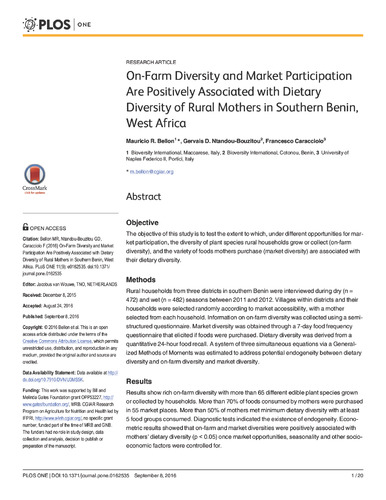On-farm diversity and market participation are positively associated with dietary diversity of rural mothers in southern Benin, West Africa
Abstract
The objective of this study is to test the extent to which, under different opportunities for market participation, the diversity of plant species rural households grow or collect (on-farm diversity), and the variety of foods mothers purchase (market diversity) are associated with their dietary diversity.
Rural households from three districts in southern Benin were interviewed during dry (n = 472) and wet (n = 482) seasons between 2011 and 2012. Villages within districts and their households were selected randomly according to market accessibility, with a mother selected from each household. Information on on-farm diversity was collected using a semi-structured questionnaire. Market diversity was obtained through a 7-day food frequency questionnaire that elicited if foods were purchased. Dietary diversity was derived from a quantitative 24-hour food recall. A system of three simultaneous equations via a Generalized Methods of Moments was estimated to address potential endogeneity between dietary diversity and on-farm diversity and market diversity.
Results show rich on-farm diversity with more than 65 different edible plant species grown or collected by households. More than 70% of foods consumed by mothers were purchased in 55 market places. More than 50% of mothers met minimum dietary diversity with at least 5 food groups consumed. Diagnostic tests indicated the existence of endogeneity. Econometric results showed that on-farm and market diversities were positively associated with mothers’ dietary diversity (p < 0.05) once market opportunities, seasonality and other socioeconomic factors were controlled for.
Results provide evidence of a positive relationship between on-farm diversity and dietary diversity among participant mothers. They demonstrate the important contribution of market diversity to their dietary diversity. Links among these three facets of diversity suggest that production for self-consumption and food purchases complement rather than replace each other in their contribution to dietary diversity and thus dietary quality.

